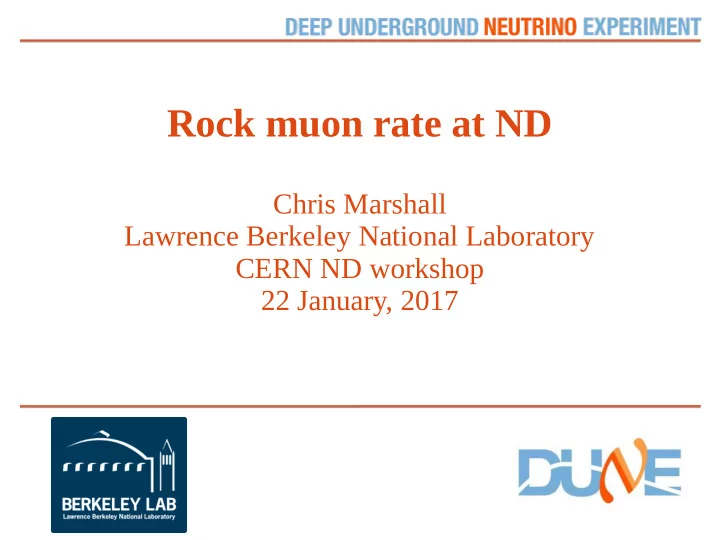

Rock muon rate at ND Chris Marshall Lawrence Berkeley National Laboratory CERN ND workshop 22 January, 2017
Rock muons ● 100s m of rock between decay pipe and detector hall ● Muons from neutrino interactions in rock will overlap with interactions in detector ● High-energy tail will produce forward, high-energy muons Earth E > 0.4 GeV/m θ < detector radius / distance 2 Chris Marshall
Questions ● What is the rate of rock muons intersecting detector? ● What is the energy spectrum at the face of the detector? ● How does this depend on the air gap between the rock and the front face of the ND? Earth E > 0.4 GeV/m θ < detector radius / distance 3 Chris Marshall
Ideal estimate ● Simulate neutrino flux, including beam divergence as a function of distance ● Simulate neutrino interactions in some large volume or rock ● Propagate muons through rock to detector ● Make plots 4 Chris Marshall
Quick, simplified study ● Distribute CC events uniformly along a line ● Use GENIE muon kinematics as a function of neutrino energy to estimate what fraction of interactions would produce a “rock muon” ● Do this for DUNE and MINERvA fluxes ● Calculate DUNE rock muon rate relative to MINERvA, and peg to observed MINERvA rate 5 Chris Marshall
Fluxes (FHC) ● Optimized 80GeV flux at ND ● MINERvA LE flux from latest flux paper 6 Chris Marshall
Event rates ● FHC ν μ CC only, integrated out to E ν = 40 GeV 7 Chris Marshall
Determine probability of muon intersecting detector ● Assume perfectly-focussed beam, perpendicular to face of cylindrical detector ● Assume flat distribution of neutrino interactions in last 100m of rock, muons lose 0.4 GeV/m (ρ~2 g/cm 3 ) Earth 100m rock 100m rock air gap 8 Chris Marshall
Determine probability of muon intersecting detector 30 < E ν < 32 GeV 0.5 < E ν < 1 GeV log(1-cosθ) log(1-cosθ) ● Use GENIE to form PDF of muon momentum and angle in slices of neutrino energy 9 Chris Marshall
Probability of intersecting detector MINERvA DUNE r = 1.08m r = 1.75m ● Integrate over the p-θ distributions to form probability of intersecting detector as a function of neutrino energy and distance from face (with 18m air gap) 10 Chris Marshall
Prob. vs. neutrino energy ● Integrate out the distance assuming flat r = 1.75m distribution r = 1.08m ● Probability that a CC neutrino interaction produces a muon that intersects the detector as a function of neutrino energy 11 Chris Marshall
Weight event rate by that probability for DUNE, MINERvA X ● Result is a relative rock muon rate between DUNE and MINERvA, per POT 12 Chris Marshall
Result ● Shown for 18m air gap, and normalized to the detector surface area 13 Chris Marshall
Result ● MINERvA LE FHC was 0.33 front-entering rock muons per 10 13 POT (1.08m radius) ● For DUNE 80GeV flux, DUNE ND with 1.75m radius and 7.5E13 protons per spill ~ 4.4 per spill with an 18m air gap 14 Chris Marshall
Air gap ● Rate rises quickly as you push detector closer to the rock ● NuMI gap is ~18m to MINERvA scintillator planes ● Plot is for 1.75m radius and DUNE 80GeV flux, based on observed MINERvA rock rate 15 Chris Marshall
Things neglected ● Focussing/beam spread differences between NuMI and DUNE ● Higher-angle events from wider-angle neutrinos, which could be lower in energy → more rock muons for DUNE ● Fluxes above 40 GeV→ fewer rock muons for DUNE ● Beam angle w.r.t. detector axis (assumed 0) ● Side-entering “rock” muons, because MINERvA can't distinguish from outer detector interactions ● Other materials in detector hall – treated as empty vacuum 16 Chris Marshall
Conclusions ● DUNE will see ~4 rock muons per spill ● This number is extremely sensitive to the flux, especially the flux tail ● This number is sensitive to the air gap between the rock and the detector because of acceptance effects ● We should think about this when designing the hall 17 Chris Marshall
Recommend
More recommend